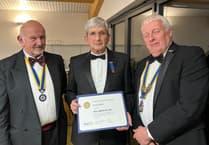A group of eight walkers met at Hound Tor car park, near Swallerton Gate for today’s route of nearly seven miles.
Hound Tor is reportedly the site that inspired Arthur Conan Doyle to write The Hound of the Baskervilles. The story goes that it was created when a mighty hunter called Bowerman interrupted a coven of witches with his pack of hounds. The witches responded by turning the hunter and his hounds to stone. A mile away you can see a rock outcrop known as Bowerman’s Nose.
The weather was, as forecast, cloudy but with good visibility and slight winds on the higher sections.
They walked along a lane towards Moorhayes and turned left on a footpath over Swine Down towards Jay’s Grave, which lies in a narrow lane junction with the footpath.
Kitty Jay was pregnant outside marriage in the late 18th century and so committed suicide. She was buried at a crossroads since the three local parishes refused to let her lie in consecrated ground.
Although the body has since been moved, the site has become something of a shrine – locals claim the flowers on the grave are left by pixies, while passing motorists often report seeing a dark hooded figure kneeling there.
The footpath continues towards Natsworthy Gate, near Natsworthy Manor, connected to the Duke of Somerset. Natsworthy Gate has a benchmark on the eastern gatepost and one of Duke of Somerset’s boundary stones, marked “PIT”, to the west. More of these boundary stones were seen on Hamel Down on a recent rambling club walk.
There are extensive views from this footpth and some walkers could remember the Giant’s Chair being here.
It was a huge sculpture, the purpose of which was to celebrate the natural environment. It had been hoped that the chair would provide an opportunity for people to appreciate the special qualities of the local landscape and to engender a sense of joy and laughter for anyone seeing it.
The six-metre high chair was placed in this location so people could stop and stare at the widespread moorland landscape below.
The Giant’s Chair appeared in 2006 and was considered by the Dartmoor National Park Authority’s planning committee in 2007 as a retrospective application. The sculpture was granted planning permission for a period of only two years, so the sculpture was removed in 2009.
On the approach to Grimspound, the ramblers noted that the colours of the heather and gorse were already fading. They diverted slightly from their path to view the Air Crew Association RAF memorial that commemorates the loss of Hampden X3054 of 49 Squadron which crashed into the hillside in 1941.
The memorial was commissioned by Lady Marjorie Cecilia Wilson, the mother of pilot officer Robert Wilson.
The prehistoric settlement of Grimspound dates from the late Bronze Age (about 1450–700 BC).
The remains of 24 stone roundhouses survive here, within a massive boundary wall about 150 metres in diameter. Today it supplied a little shelter for the group to enjoy their picnic lunch, admiring the views from this commanding position.
The visibility remained good as they walked along a footpath from Grimspound towards Heathercombe Brake, enjoying views towards Hay Tor.
At Heathercombe the walkers joined the 2 Moors Way (E) back towards Natsworthy Manor, retracing their steps back to the car park below Hound Tor, where they very much appreciated the ice creams, hot drinks and cakes served by the mobile truck.
New walkers are always welcome at Okehampton Rambling Club. Please be suitably attired for all weather conditions, including sturdy footwear, and bring drinks and packed lunch. Meet at the post office in George Street, Okehampton, on Sundays ready to leave at 9.30am.
We share cars so please be there in plenty of time so the group can leave promptly. Car drivers with spare seats are encouraged to meet at the post office to offer lifts to non-drivers. Next week’s walk is from Throwleigh Common.




